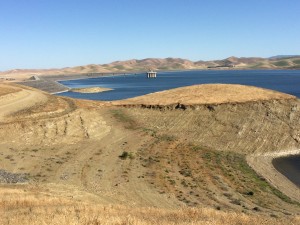I was sitting in on a panel discussion the other day, and heard an interesting prompt: Is California’s current water problem a storage or usage problem? From gauging the audience, it appears that most of the audience thought it was a usage problem.
Lets look at the two options:
Storage problem. According to Wikipedia, there are over 1400 named dams in California with around 1300 reservoirs. Most of these reservoirs are small and within metropolitan water districts. Surprisingly, most of the recent dams built were in Southern California, with few large dams (>200,000 acre feet) built since the 60’s. The most recent large dam was completed in 2003, the Diamond Valley Dam, creating Diamond Valley Lake, located near Hemet, CA. More recent smaller dams have been built to service municipalities. To top it off, most major rivers within the Sierra Nevadas have been dammed multiple times in order to mitigate floods and capture snowpack.
There are ways we can build capacity to store more water. Of course, a new dam could be built, such as the proposed site in Temperance Flat, but dams could also be built higher. Raising a dam is often cheaper and greatly increases the storage capacity of the lake since the highest surface area is being dammed. A second option is groundwater banking. This strategy would apply water to soils with conditions suitable for groundwater banking during wet years, helping to replenish what is pumped during dry years. This strategy would require some research and some infrastructure improvements, but for the most part could take advantage of creating a large reservoirs of water in the gravel layers beneath our feet. This would provide a much larger capacity than above ground storage.
Usage problem. According to California’s Department of Water Resources (DWR), in a “normal year,” water allocations are split 42%, 47%, 11% Agricultural, environmental, and urban usage, respectively.
Agriculture has been under scrutiny for its water use for some time, and many have adopted low volume, pressurized drip or mini-sprinkler systems. Although not all commodities are up to the same standard, roughly 70% of the almond industry has adopted drip or micro-sprinkler irrigation while 83% of surveyed use need-based irrigation scheduling. My experience with other commodities match the above survey findings – the majority of farmers use need based scheduling, while well over half have been using drip-systems – even in tomatoes. I was actually shocked to see drip systems recently installed in a cotton field!
So how can agriculture improve? Working to adopt technologies and utilizing them efficiently over the rest of the various commodities seems to be the easiest place to start. This is what the Pacific Institute’s most recent study in water has indicated — that 17-22% less water could be used it these technologies were utilized over the entire ag industry.Also, the following could also provide savings: sub-surface drip systems to reduce evaporation losses (needs research), better water scheduling equipment and software, and crops that allow groundwater banking and versatility in planting schedules (needs research).
What about the urban usage? Although only 11% of CA’s surface water use, there are still gains to be made in the urban setting. Metering water – and the respective charges, had made most Californian’s more conscience about water. In saying this, even though the law that required all homes and places of business to have a water meter by 2013, more than 250,000 homes still were without a meter in 2014. This flat fee service leads to water waste – and not too surprisingly – most homes without meters are older, larger homes with large lots (and most likely high water use). Other considerations include better utilization of water in the landscape, better landscape design, recycling of water within cities, and better metering and a system for charging. Of course, there are many things around the home which we can all do better- shorter showers, multiple toilet uses before flushing, eat less meat, etc.
Finally, the last and largest piece of the puzzle that MOST people forget about – Environmental water use. This is all of the water that is captured by the dams and released to maintain flows within the various rivers. What is interesting, is that although we have been managing flows on CA’s rivers for many years, there is MINIMAL research that provides information on what is the best timing and how much flow is required to maintain wildlife habitat. This includes how much water to release at what time for salmon spawning, what amounts are needed to restore gravel beds and to lower water temperature. Also, populations of invasive species that feed on native fish – such as the striped bass- could be managed or reduced.
Although it is clear that CA could benefit from an update of its water storage infrastructure, it is quite clear that there is still a lot of savings through more efficient usage.

Leave a Reply